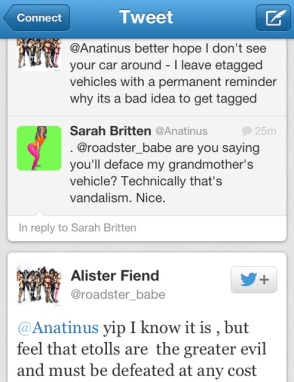Once upon a time, e-tolls galvanised society. Like no other cause before or since, the hatred of e-tolls cut across class, politics and race. They were a superb nation-building tool, something I reflected on here.
But things have changed. When e-tolls were finally implemented in early December, the battle was lost. Quite possibly the war, too, judging by the number of people signing on. (Sanral claims that just under one million e-tags have been registered.)
I can understand why: e-tolls are a reality now, and a lot of people are betting that it’s cheaper to get the tag and at least have some certainty than have to wait for threatening SMSs and who knows what.
That’s what motivated me, in part, to queue at an e-tolls customer centre kiosk at a shopping centre in Sunninghill today. Initially, I’d vowed to avoid the highways or just not pay. I’d driven under goodness knows how many gantries. But I was in my grandmother’s car at the time and, not wanting an 88-year-old woman to field queries from Sanral, I went to sort out what was owing.
Now, I’m not usually a spineless goody two-shoes; in general, I favour procrastination over compliance. I haven’t paid my TV licence, mainly because I don’t own a TV. And I’d have been more open to a bit of LeadSA-sanctioned civil disobedience if it was entirely up to me, but my family asked me to make sure I was up to date with e-toll payments. Those close social ties are much more of a motivator than the weak ties of social media or the comments facility.
So off I went. I waited more than 20 minutes — an A4 sign in the window informed customers that the system was slow — and busied myself by checking on the various social media accounts I manage. The Sanral employee I eventually dealt with was perfectly pleasant, the process itself was quick, and I was charged less than I had anticipated: just under R24.
What was less pleasant was the response to my tweets about what I was doing. The mockery was something I expected:
But being threatened with vandalism?

Even if this person doesn’t know my car registration, this kind of response is so out of touch with what might be considered sane, reasonable behaviour that perhaps a stint in Sterkfontein with the fake interpreter is in order.
Oh, I knew that I was taking a chance by tweeting about paying e-tolls. Keeping quiet would have been the sensible thing to do, but sensible has never been my strong suit. Since I’m honest about a lot of things in my life, I didn’t see why I should exclude this just because some felt that I was letting down the side — that somehow, my decision to pay what was owing (I didn’t sign up for an e-tag) threatened all of us.
Responses like this are a form of bullying and just as bad as the threats issued from Sanral themselves.
And yes, Sanral is easy to hate. They might not, technically, be a four-letter word, but they might as well be. Here’s the thing though. When some self-righteous Twitter follower threatens me with violence, I start to wonder about anti-e-toll hardliners. I start to think that Sanral isn’t all that bad. When a brand is perceived as a bully, the best thing that can happen is that it gets picked on by the kind of people who earn little sympathy. Woolworths was public enemy number one after the Frankies debacle, but then the Halaal hot-cross buns came along and saved the day.
That’s the same reason that the Westboro Baptist Church is the best thing ever happened to gay rights, because it forced fence-sitters into the middle through the sheer insanity of its extremism.
If I were Sanral, I’d be thrilled at this development. From a perception-management point of view, this kind of crass peer pressure is a gift. Vusi and Nazir, meet your new best friends.



